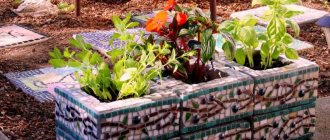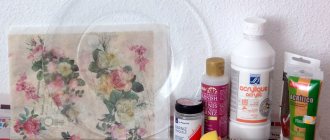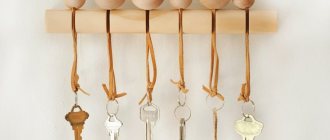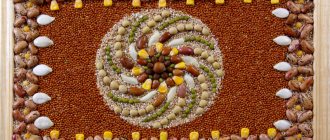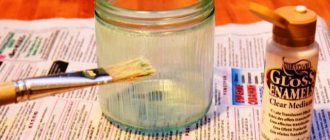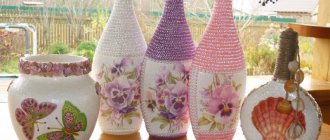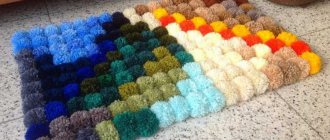The decoupage technique has been known since time immemorial; Even in the Middle Ages, Venetian masters successfully mastered it, adopting the art of decorating furniture with carved images from their Chinese colleagues. Nowadays, decoupage is associated with interiors in the Provence style, shabby chic, with palace interiors in the spirit of Baroque, Rococo, and classical design. This is due to the fact that the technique is used to update old furniture or give new pieces of furniture an aged effect. In both cases, chairs, sideboards, coffee tables, chests of drawers, cabinets and stools acquire individuality, and sometimes a new life.
Types of decoupage
The basic principle of decoupage is gluing the prepared surface with different materials, followed by varnishing. However, this technique has several subtypes. Some of them require certain skills, others are quite accessible to beginners who dream of restoring or simply decorating furniture with their own hands. The following are used as finishing decorative materials:
- wallpaper;
- textile;
- napkins and decoupage cards;
- drawings printed on a regular or 3D printer, clippings from magazines, newspapers (as in the photo below).
Kitchen decoupage options
There are several options for designing a kitchen interior. When decorating in a peasant style, the following patterns are selected: wildflowers, butterflies, cats, dogs. For a kitchen updated in the style of a classic landscape, designs such as vines, flower bouquets, and angels are suitable. It would be good to apply the gilding technique to this style.
Modern style involves the use of various geometric shapes, black and white newspaper clippings, photographs from magazines and other elements. Very often, with this decoupage, zebra or leopard colors are used.
This is interesting! Decoupage of furniture in Provence style: style features and detailed master class, video from a specialist
The process of decoupage furniture with wallpaper
Regardless of the chosen technique and method of decoupage, the surface must first be prepared by walking over it with a grinding machine or treating it with sandpaper. This is done in order to remove paint and varnish when restoring old furniture. If necessary, a solvent is used. Cracks and chips are treated with putty. If you plan to create a collage from pieces of different wallpaper with gaps, you need to apply background paint to the prepared surface.
If you plan to cover large areas, the fronts of dresser drawers, countertops, or the inner wall of a shelving unit, you can do without paint. The wallpaper is glued with wallpaper glue and carefully smoothed with a roller or a clean cloth, starting from the center towards the edges. After the glue has completely dried, several layers of varnish can be applied to the wallpaper.
You can update a coffee table with your own hands without using acrylic: just cut out a suitable piece of wallpaper and place it on the tabletop, and then cover it with glass. This option is suitable for those who have not yet mastered the art of decoupage or are not sure of the correctness of the decision. If desired, the table can be quickly returned to its original appearance.
Dining table decor
You can modify a glass dining table using the reverse decoupage technique. This is a good option for the kitchen, because the image will not be subject to mechanical stress. The glass kitchen table must be turned over and the surface thoroughly degreased from the inside using alcohol-based products. The work then looks like this:
- For better adhesion to napkins, the table is pre-coated with a primer (it is advisable to choose a white color).
- While the soil dries, cut out the image: it is better to do this carefully, without interspersing the surrounding background.
- From the inside of the tabletop, the motifs are gradually glued with a flat brush and PVA: it is important to release all air bubbles during the work so that the design fits perfectly.
- The glued image must dry, after which it is covered with several layers of varnish.
The apartment is immediately transformed after the restoration of the kitchen table: guests will not be able to contain their admiration when they see such an original dining table, restored with their own hands.
Decoupage of a blue chest of drawers
How to make decoupage with fabric with your own hands?
Since fabric is very different in structure and other characteristics from paper, updating sideboards and chests of drawers with pieces of fabric requires a special approach. You should carefully consider the future composition, arrange the scraps according to colors and prints so that the final picture looks harmonious, not clumsy, and fits well into the interior of the room.
Updating a table, chest of drawers or cabinets begins with removing old paint using a solvent. Then the surface is sanded, leveled, primed or painted. PVA glue is applied to the furniture, and pieces of fabric are impregnated with special glue for decoupage and carefully glued to pre-designated areas. The fabric is repeatedly treated with glue from a spray bottle, then the future masterpiece is allowed to dry and covered with 3-4 layers of acrylic varnish.
An alternative to decoupage using fabric is stencil painting of old furniture. In this case, instead of a stencil, you can use old lace, tulle and other openwork materials.
Modern style
Do-it-yourself wardrobe decoupage in a modern style will make your bedroom more comfortable and harmonious. To complete this decorative work you will need the following materials:
- wallpaper in neutral colors and discreet pastel colors;
- voluminous flowers, butterflies;
- rhinestones, beads.
Instructions for performing the work:
- If you decide to extend the life of an old polished cabinet, its top layer must be removed using sandpaper, otherwise it will be very difficult to glue the paper.
- Glue the paper using the traditional decoupage method, cover with varnish and let dry.
- When the material has dried well, glue three-dimensional elements in random order - flowers and butterflies, and decorate the wardrobe doors with rhinestones and beads.
Decoupage technique with napkins and special cards
The process of decorating using napkins or cards is simple and suitable for beginners. Classic techniques for restoring old and personalizing new furniture are used for processing dishes, glass surfaces, various containers (caskets, boxes), decorating cards, Easter eggs and homemade accessories.
You can use multi-layer napkins with pictures or professional cards for decoupage. The napkins are divided into layers, and the layer on which the images are printed is selected. The designs are cut out with nail scissors or torn out by hand (the process goes much faster if you have decoupage cards in your hands) and applied to the prepared surface (wood, cardboard, metal, plywood, chipboard), treated with PVA glue. The designs are smoothed with a brush, roller or dry, clean cloth, dried and varnished (when decorating Easter eggs, it is recommended to use egg yolk).
The process of decoupaging furniture with newspaper clippings, printouts of paintings and plots (the latter are best done on thin carbon paper) is similar to decorating with napkins and special cards.
Decoupage motives
A kitchen cabinet can be turned into a real man-made miracle, colorful and bright. And it doesn’t matter what style you are going to do it in: ethno, Provence, country, classic. The most interesting and favorite patterns by craftsmen:
- Folk motives;
- Small meadow or wildflowers;
- Grapevines;
- Apples-pears;
- Lilac;
- Angels on a floral background;
- Birds;
- Mosaic.
Such decoupage may resemble patterns from the beginning of the last century that romantic young ladies used to decorate household items and their personal belongings (boxes, for example). The chic of those things resonates in modern style, where there is always a place for retro, even if created on your own.
Some techniques and types of decoupage
Over the entire existence of the art of decorating surfaces with glued patterns, the following varieties of decoupage have appeared:
- classical;
- volume;
- smoky or artistic;
- back;
- decopatch.
Classic decoupage involves applying napkins or cards with drawings to the surface of furniture using a dry, wet or hot method. After the glue has dried, the picture can be tinted, given various effects, and then covered with acrylic varnish.
Volumetric decoupage is performed using stencils and drawings printed on a 3D printer, napkins, fabric, and various additional materials (modeling pastes, gels, putties, paints). The effect of depth is achieved by drawing the background and shadows and requires a high level of artistic skill from the performer.
Artistic decoupage also involves the use of special paints for the background and processing of the design itself. The surface of the furniture is painted in several tones, the paints are mixed to give the image a vague, fuzzy, airy feeling. It is not for nothing that this technique is called smoky, since mixing pastels and acrylic paints creates the effect of a real painting with a deep background, as if filled with clouds of colored smoke.
Reverse decoupage differs from classic decoupage in the sequence of actions: a pattern is applied to a transparent surface, then the glass is primed and varnished. In this way, transparent doors of kitchen cabinets, sideboards, and decorative dishes are updated.
Decopatch is a tandem of patchwork and decoupage techniques. Pieces of special paper imitating stone, fur, fabric, other textures and materials, as well as old newspapers are glued close to each other or overlapping, creating a background picture with stunning effects. After the glue has dried, the decor is varnished.
Decoupage styles
This decoration technique is divided into several varieties. Each type has its own distinctive features:
- direct decoupage (prepared elements are glued to the surface followed by application of varnish);
- reverse (gluing is carried out from the reverse side, this type is only suitable for furniture with transparent elements);
- artistic (sticking an element, painting it using brighter colors);
- volumetric (after gluing the element, its individual parts are highlighted using fabric, modeling paste, putty, artistic gel);
- deco patch (not one fragment is used, but many small elements laid out according to an invented scheme; the technique is essentially reminiscent of a mosaic).
Experienced craftsmen prefer to use small secrets and special techniques that enhance the effect of decoupage. These include:
- the use of special paints that can give the image metallic shades (gilding, silver);
- tracing the outline of the drawing with colored pencils or paints in order to give it additional brightness and expressiveness;
- artificial aging;
- craquelure aimed at “creating” cracks;
- adding shadow to all elements;
- patination (a special technique that imitates fading of paints).
Decoupage will be appropriate when updating an interior made in any style. It is only important to correctly determine which elements will be most appropriate.
Artistic processing with different effects
For craftsmen who have mastered various DIY renovation and restoration techniques, it will be interesting to learn how to make tables, cabinets and cribs even more elegant and sophisticated. Thus, the following artistic processing methods are combined with decoration using the decoupage technique:
- toning (applying layers of colored paint to give the drawings a special shade);
- patination (imitation of a thing “with history” using black, colored, dark patina on corners, edges, places of contact with human hands);
- aging (artificial creation of abrasions, a retro effect using wax and sandpaper);
- gilding (coating the design with gold, silver, bronze paint, giving the piece of furniture a luxurious and exclusive look);
- craquelure (creates the effect of a coating cracked by time, for which a special varnish is applied to the design on top of or between two layers of paint).
Popular effects
There are several popular decoupage effects:
Hallways 2021: TOP-200 photos of the best new products and modern design. Options for the ideal combination of color and style of furniture in the hallway- DIY stool: manufacturing methods and instructions for creating simple and stylish models (90 photo ideas)
- Do-it-yourself door finishing: 115 photos of the best options for entrance and interior doors
Gilding. The pasted picture is covered with a layer of golden, silver or other metallic paint. If the budget allows, then gold leaf or a cheap fake will do. If you look at the photo of decoupage furniture with gilding, you can see that it adds luxury to the interior.
Formation of artificial abrasion. A good option if you need to decorate a room in a retro style. This decoupage of furniture will give guests the feeling that all the interior items have survived several decades. To achieve the desired wear, the surface is waxed, painted, and then sanded.
Craquelure is an interesting effect that allows you to create artificial cracks on an object. To work you will need a special varnish. The surface is processed in stages - regular paint is applied, varnish and paint again. When the top layer dries, the object will become covered with small decorative cracks. Another way to visually age an object.
Master class on furniture decoupage for beginners
Decoupage is a universal technique that is accessible even to untrained beginners. With the help of simple techniques, you can update furniture with your own hands, disguise small defects, and add special chic and flavor to inconspicuous and faceless pieces of furniture, even new ones. For decoration, you can choose any drawings and motifs, which will allow you to make a table or cabinet using the decoupage technique an organic element of the interior in the style of Art Nouveau, Provence, retro, classic, ethno, country, modern or oriental apartment design. It is recommended to start mastering the technique with the simplest method of decoration using napkins.
Materials and tools
To decorate wooden furniture with napkins you will need the following supplies:
- the napkins themselves or printed drawings;
- scissors with sharp blades (special, manicure or medical) and a sharp scalpel (for applications made of thick paper);
- glue (PVA, wallpaper, egg white or special for decoupage);
- acrylic lacquer;
- putty or primer;
- acrylic paints, pastels, tinting paints for backgrounds;
- brushes (for glue, varnish, paints);
- solvent, grinding machine and sandpaper for surface preparation;
- sponge, napkin or roller for smoothing the pattern.
Step-by-step instruction
The master class on decoupage of a cabinet door or wooden tabletop includes the following steps:
- Surface treatment with solvent (removal of old paint), sanding (removal of varnish, uneven surfaces).
- Apply primer or putty to level the background, fill cracks and chips with wax.
- If desired, the surface is painted in a pre-selected shade with acrylic paint (it is better to choose a light tone, since the translucent napkin will be invisible against a dark background).
- The top layer with the pattern is separated from the napkin, it is cut out with scissors or torn out by hand.
- The glue can be applied in two ways: on the surface of the furniture or on the back of a napkin. In any case, the design is saturated with glue and then carefully smoothed with a brush or roller.
- After the glue has dried, acrylic varnish is applied in 3-4 layers with intermediate drying. For the first experiment, it is better to choose an aerosol can.
The good thing about decoupage is that this technique can be improved, each time introducing new creative ideas into the process and achieving unusual visual effects. Any theme, plots, style - applications on furniture will help you realize your wildest fantasies at minimal cost.
I like 0
Decoupage Furniture decoupage Furniture Furniture restoration Furniture restoration Handicrafts Handmade Interior Interior design Design
Related Posts
leave a comment
Only 3 comments.
153759vlad
with us 2 years, 2 months, 27 days
2019-05-21 10:32:46For such work, you still need a 2 mm PVC edge, you can find it in Nison and then all the corners and bends will be easier to make, judging from my experience, but this is an option
153759vlad
with us 2 years, 2 months, 27 days
2019-04-28 13:33:33beauty and how much painstaking work
Alina
with us 2 years, 11 months, 29 days
2018-07-27 14:03:04Thank you for the interesting information. I also do decoupage, I like to give a second life to old furniture. A fun activity that develops your imagination and helps you take your mind off the daily hustle and bustle. At first I was faced with the problem of removing varnish from furniture, I didn’t know how best to remove it, sometimes I used acetone, the smell of course was not the best. My husband, seeing that I couldn’t do it, brought me a solvent from work, I don’t remember the number, but it became easier to work with. His team, which works in the leather and footwear industry, always purchases everything they need for their work on the DCP website https://www.dcpt.ru/ This enterprise is one of the oldest in the industry of production of products for paint and varnish, rubber butyl acetate and food acetic acid , so they are famous for quality.
Types of decoupage techniques
Decoupage is a technique that came to us from France. This word translates as “cut”: the master cuts out small drawings from paper, napkins and glues them to the surface. This idea allows you to decorate a large number of interior items, including furniture. Among the varieties of decoupage are:
- classical;
- straight;
- back;
- art;
- deco patch;
- craquelure;
- volume;
- casting shadows.
A brief description of each of them will help you choose your own design option for interior items and furniture.
Decoupage of a chest of drawers with notes
Classic or straight
Direct or classic decoupage is the first technique that beginners need to master when decorating furniture items. This option is perfect for initial experiments. The essence of classic decoupage is as follows:
- A drawing is selected - it can be printed on special paper or used on a paper napkin.
- The napkin is peeled off and the desired beautiful design is cut out of it.
- The surface is prepared and degreased. This could be a wooden table or a glass cabinet.
- The design on the napkin is applied to the surface and coated with PVA glue diluted with water or a special composition for decoupage.
- When the glue dries, the surface is coated with varnish to secure it.
Do you want to get a brand new bedside table without spending any money and experiencing maximum creative pleasure? Then repurpose old furniture using the decoupage technique.
Do you want to get a brand new bedside table without spending any money and experiencing maximum creative pleasure? Then repurpose old furniture using the decoupage technique.
Using classic decoupage, you can restore shabby furniture: the result is a variety of products in a modern or vintage style. You can also repair some items by deliberately masking defects under a picture.
Decoupage stools
Features of reverse decoupage
Design using this technique is only suitable for transparent surfaces, so the technique will be an excellent option for glass restoration. The principle of decoupage is to glue the picture with the reverse side to the plane so that the picture is under the glass. It is necessary to carry out fixing work on the image: cover it with various finishing materials and varnish.
It is logical to use reverse decoupage to remake a glass table or sideboard inserts; it can be used to decorate glassware, as well as a buffet display case.
Beautiful decoupage of furniture
Artistic technique
This type of technique differs from the previous ones in that after gluing the main pattern, a kind of haze is created around it. That is why the second name of this decoupage technique is smoky decoupage. Thanks to artistic restoration, volume is created on the surface, and the drawing does not seem flat.
A console chest of drawers is a great thing for experimenting. To show your creativity, just buy multi-layer napkins and devote yourself to restoring old furniture.
Volume is achieved by using additional colors of similar shades. To stretch the image a little, the artist uses colors that are a shade darker or lighter. Artistic decoupage is often combined with painting - the technique is perfect for decorating tables, shelves, and the surface of stools.
Decoupage and painting of a chest of drawers
Decopatch
Design in this technique is built according to the following stages:
- The napkin tears into small pieces.
- Its parts are glued to the surface one by one.
- Thanks to overlapping gluing, volume and an original pattern are created.
- The technique is suitable for decorating round and convex objects.
- At the final stage, the work is varnished.
The surface must always be degreased before work. Decoupage of furniture using the decopatch technique is best done on a variety of spherical surfaces: lampshades, balls, round objects.
Decoupage of a chest of drawers in Provence style
Adding shadows to the edges of the picture
A romantic version of the decoupage technique - creating shadows - is used for a three-dimensional picture. The work is done in this way:
- A motif is cut out and glued from a napkin or special paper.
- An additional shadow is created around the motif: this is done using acrylic paints and a dry brush or sponge.
- Place a very small amount of paint on a sponge or brush and carefully move along the edge of the print.
To make the shadows deep, the artist uses shades one tone darker than the main color of the image. To prevent mistakes, you must first coat the drawing with varnish, and then draw shadows.
Decoupage chair in the living room
Craquelure
You can achieve the desired effect in two ways: stick on small eggshells or purchase a special varnish that creates a network of cracks on the surface of the furniture. This technology allows you to restore furniture in vintage style: the finished product turns out to be a little shabby, but has an original design. Using varnish, the work is done as follows:
- The surface of the furniture is painted in the chosen color - it is better to choose a white or beige shade.
- Small or large eggshells are glued onto the surface.
- Then a napkin motif is cut out and glued to the center of the product.
- Cover the work with protective varnish.
This simple design can be created using craquelure decoupage. Are you ready to get such a luxurious item without purchasing new furniture? Then feel free to get to work!
When using varnish, there is no need to glue eggshells. A wooden cabinet or other furniture is simply polished, the base is cleaned with sandpaper, and painted with acrylic. Then a napkin is glued on and covered with craquelure on top. For cracks to appear, it is enough to wait for the varnish to dry or use a hairdryer to speed up the process.
Painting an old chair
Volumetric decoupage
As the name implies, this technique is designed to create volume in the composition. For this purpose the following materials are used:
- textile;
- lace;
- napkins or rice paper pasted in layers.
Decorating old furniture with lace or fabric allows you to hide unevenness and defects on the surface. Volumetric decoupage is suitable for decorating furniture in Provence or vintage style, as well as shabby chic.
Decoupage of a white chest of drawers in Provence style
All of the techniques listed can be used to remodel antique furniture sets step by step. To make the work go faster and avoid mistakes, it is recommended to initially master the technique of classic direct decoupage.
Decoupage furniture in shabby chic style
A simple way to decoupage a tabletop
We bring to your attention step-by-step instructions on how to decoupage a kitchen countertop. For work we will need:
- Sandpaper;
- Liked image;
- Primer for wood;
- White acrylic paint;
- Thick brush for glue and primer;
- PVA glue. Furniture composition is suitable for decoupage;
- Protective varnish;
- Scissors and a simple pencil.
Using sandpaper, remove the paintwork from the wooden tabletop. When the surface acquires a matte tint, you can proceed to applying the primer.
Apply a thin layer and wait for it to dry completely. This may take from 1 to 3 hours. The substances included in the primer ensure good adhesion of decorative parts to each other.
Paint the surface of the countertop white. Apply acrylic paint in three layers. Each of them must dry within one hour.
We cut out the image and proceed to laying out the decoration on the plane. We mark the boundaries with a simple pencil. Carefully glue the picture to the surface of the table. After this, apply several layers of glue and wait for it to dry completely.
The final stage will be the application of a protective coating. To do this, we coat the surface of the tabletop with varnish. To create a thick film you will need 4 layers.
Decoupage polished furniture
We considered the option of decoupaging wooden furniture, but what to do if you don’t want to part with your old polished chest of drawers? It is difficult to glue a paper design onto smooth glossy surfaces, but it is quite possible.
How to apply paper fragment to polished furniture:
- First you need to use coarse sandpaper to remove the shine. It is very difficult to completely remove polishing; this work is long and painstaking. It is important to try to at least thoroughly clean the top to get rid of the shine. It’s good if you try and carefully follow all the recommendations so that there are no glimpses at all. Then you can count on long-term “wear” of the pattern.
- If there are defects on the furniture: cracks, bulges and unevenness, we carefully fill everything with special grout or putty. We wait for these areas to dry, apply a layer of primer, and again wait for complete drying.
- Polished furniture will not have as beautiful a pattern as furniture made from wood. Therefore, you need to work with a primer to make the surface “sparkle.” We use acrylic paint as a primer mixture (we select the shade to match the tone of the furniture).
- We cut out the desired fragment from a decoupage card or napkin and glue it to the surface using special glue.
- Carefully smooth the print with a brush or foam roller to remove air bubbles and creases.
- Now you have to correct the background. We do this using acrylic paint and a thin brush. We draw the outline; if necessary, we enliven the drawing with paint, drawing individual details.
- Carefully level the finished surface and apply a layer of varnish as a fixative. We wait for it to dry, cover it again with a layer of varnish, wait for it to dry and repeat our steps again.
- If you are updating furniture in the kitchen or bathroom, then you need to apply a final coat of clear varnish, and then, when it dries, apply a thin layer of wax. This surface looks more impressive.
Here is the result of the efforts:
Methods of decoupage techniques used
- Method number one. The easiest way to decoupage from napkins. This is a simple process of cutting out a picture along the contour, placing the picture on the object and securing it with glue. As soon as the picture is dry, it must be varnished.
- Method number two. In reverse decoupage, we take a transparent surface. The design is applied with the front side facing the glass. Once dry, apply the varnish.
- Method number three. Artistic composition. In order to create it, we take a lot of drawings, and when gluing them, we collect them into one whole. We add different accents, shadows and painting.
- Method four. This method is called "decopatch". For it we take newspapers, photos from a magazine, images on fabric. In order to erase clear boundaries, their edges are torn off and the entire surface is filled with these pictures.
- Method number five. We make a three-dimensional drawing. This method requires the skills of an artist. To begin, we glue the design from a paper napkin. Then we start painting on it and carefully draw out all the smallest details.
Features of decoupage
Decoupage is widely used to decorate various types of surfaces. It is great for glass plates, decorative panels and ceramic products. The essence of the technique is to cut out a decorative image and then fix it on the surface.
As a result, the decorations can be updated regularly. For example, an old floor vase can easily be transformed into a real masterpiece. To do this, it is enough to use an unusual image and several layers of adhesive.
You can add some zest with sparkles, large rhinestones or beads. To fix them you will need special glue.
Master class on decoupage of a Victorian style coffee table
You can beautifully decorate a coffee table in Victorian style. Here we need napkins with drawings of lush bouquets, angels or girls in ancient clothes.
To update our table with your own hands, first of all you need to prepare the surface. It should be clean and smooth. We remove old varnish and paint using sandpaper. Then we prime the surface. We can use PVA glue or regular water-based paint as a primer. Now we carefully cut out our designs and remove the two bottom layers of the napkin, leaving only the top one with the design. Carefully place the drawings face up on the table surface and use a brush to apply a layer of glue to the drawing from the center to the edges. Make sure there are no bubbles. Dry the surface . And apply two layers of varnish. This completes the decoupage of the table.
